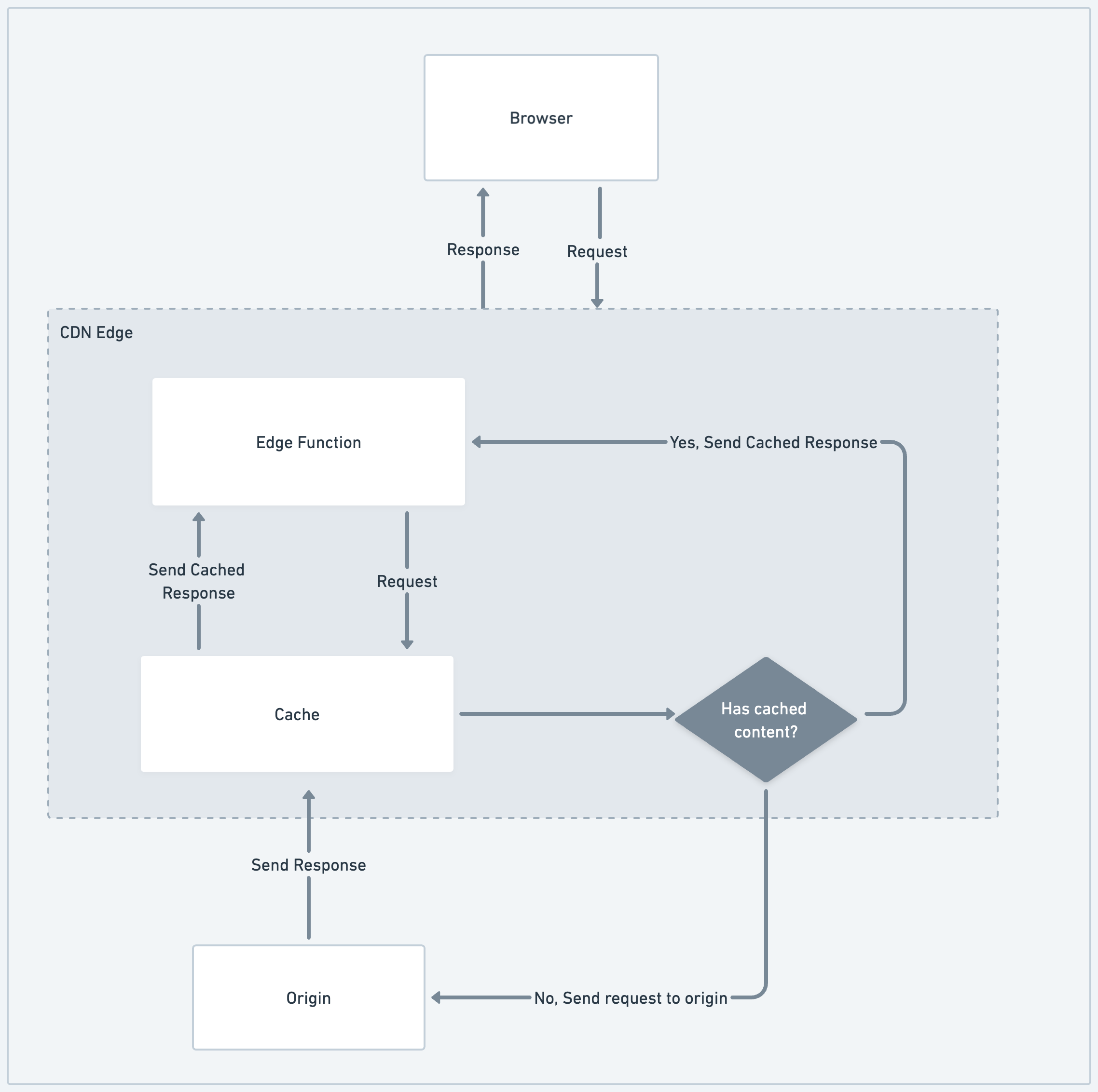Revolutionizing digital experiences with edge computing

Edge-driven architecture has fundamentally transformed traditional computing models, offering improved efficiency, faster response times, and instantaneous decision-making. In this blog, we delve into the utilization of edge computing in Contentstack and its role in keeping us at the forefront of the constantly evolving digital realm.
Understanding edge computing
Edge computing involves executing computational tasks and storing data in proximity to the user's location. It serves as the backbone of modern Content Delivery Networks (CDNs), where globally distributed edge servers respond to user requests in real-time. Requests are directed to the nearest edge server for immediate processing and analysis, resulting in minimal latency and expedited content delivery.
This approach optimizes response times, conserves bandwidth, and encompasses tasks such as load balancing, content caching, user experience enhancement, CDN performance improvement, security reinforcement, and ensuring high availability. Overall, edge computing significantly benefits architectural design by enhancing efficiency and responsiveness.
Edge architecture
Here’s a glimpse of how the edge architecture functions.

Upon receiving a browser request, it first reaches the nearest CDN edge server. The server then examines the request for cached content. If found, the cached content is promptly sent back to the browser for rendering. Alternatively, if no cached content is available, the request is sent to the origin server for processing. After processing, the origin server sends the response to the edge server, where it is cached and subsequently delivered to the browser.
The significance of edge computing
The significance of edge computing lies in its pivotal role in data processing, bringing computation closer to data sources. This approach not only streamlines content delivery but also greatly enhances security, performance, scalability, and reduces latency. Here's why embracing edge computing is crucial:
- Security measures such as DDoS mitigation and content encryption.
- Improved performance and scalability due to reduced response times.
- Direct response delivery from edge caches, reducing load on origin servers.
- Minimal latency as requests are processed closer to end-users.
Applications of edge computing
Edge computing finds its utility in a diverse range of applications, such as:
- Dynamic web applications benefit from distributed content delivery, processing, and server-side logic, enhancing user experience.
- Edge computing aids in SEO by improving website loading times through efficient content delivery and rendering.
- Personalization is enabled by edge computing through real-time processing, offering tailored user experiences.
- Website security and privacy are enhanced with threat detection and security protocols at the edge, protecting sensitive data before reaching central servers.
- Edge computing facilitates real-time bot mitigation by analyzing patterns and behaviors to detect and block malicious bot activities.
- Real-time image transformation is facilitated by edge computing, allowing for image processing and transformation based on user preferences closer to the end-user.
- User tracking and analysis benefit from edge computing, enabling real-time collection and analysis of user data to provide insights into user behavior.
- A/B testing is made more efficient with edge computing, allowing for dynamic content delivery based on user segmentation at the edge.
- API performance is optimized by edge computing through distributed processing tasks across edge servers.
Utilizing edge computing with Contentstack
The enthusiasm surrounding edge computing arises from its transformative potential across various industries and business functions. Here are a few real-world use cases of edge computing in Contentstack.
Website personalization
Website personalization involves tailoring the website experience for each visitor, aiming for increased conversions, sales, and customer satisfaction. Contentstack is prioritizing edge computing to deliver personalized experiences efficiently at the edge of the network, ensuring a seamless user experience.
Edge architecture for personalization
Requests for web pages are directed to the edge, where personalized information is added to the URL. If cached, the CDN delivers the personalized page directly; if not, the request is forwarded to the origin for rendering, with the response then cached and delivered to the browser.

Benefits of edge-driven architecture for personalization
- Ensures consistent personalization across devices.
- Eliminates flickering associated with client-side personalization.
- Enhances security by providing minimal client information.
- Enables users to view the latest experience based on navigation changes.
Password protection
Password protection ensures non-production sites remain inaccessible to the public. While latency is insignificant for non-production sites, password protection can be implemented at the origin. However, this approach has drawbacks.
Edge, a CDN component, handles incoming requests, directing them to the origin for initial validation. Subsequent requests utilize cached responses, enhancing security and leveraging CDN caching features.
Edge architecture of password protection
Upon browser request, it's directed to the nearest CDN edge server. The edge function authenticates user credentials, directing valid requests to the data store for validation. If authenticated, cached content is sent to the browser for rendering. Otherwise, if no cached content exists and the request is authentic, it's forwarded to the origin server. The origin server processes the request, and the response is cached at the edge server before being sent to the browser.

Benefits of edge for password protection
Using edge computing for password protection offers several benefits, enhancing security and efficiency in comparison to traditional centralized approaches. Here are some advantages:
- Enhanced security: Validation at the edge prevents unauthorized access to the origin.
- Leveraging CDN caching: Utilizes caching features for improved performance.
Rewrites and redirects
URL redirection directs specific URLs to preferred destinations, improving user experience by managing updates, opt-in forms, and fixing broken links. URL rewrite enables server-side modification of URL paths, ensuring consistency during changes and seamless mapping from old to new URLs during website updates.
Rewriting and redirecting URLs are crucial tasks in production environments, where minimizing latency is essential. Utilizing the edge for these operations reduces latency by processing requests closer to the end user, resulting in faster response times.
Benefits of edge for rewrites and redirects
Edge computing offers several benefits for rewrites and redirects, enhancing the efficiency and performance of web applications. Here are some advantages:
- Reduced Latency: Directing requests through the CDN's edge decreases latency, enhancing response time.
- Decreased Calls to Origin: Edge-based rewriting reduces the number of calls to the origin server, optimizing performance.
In conclusion, leveraging edge computing architecture presents a transformative opportunity for enterprises to revolutionize performance and efficiency. By conducting computations closer to users, businesses can achieve unprecedented speed, security, real-time responsiveness, and personalization in delivering experiences. As technology evolves, integrating edge computing into architectural designs will undoubtedly shape the future of digital experiences. Contentstack embraces edge-driven architecture to optimize content delivery, enhance security, and improve user experience.
For developers interested in exploring edge computing, CDNs such as Fastly and Cloudflare and cloud providers such as AWS (Lambda@Edge) and Azure (Azure IoT Edge) provide valuable resources and tools for efficient deployment and management of applications at the edge.
About Contentstack
The Contentstack team comprises highly skilled professionals specializing in product marketing, customer acquisition and retention, and digital marketing strategy. With extensive experience holding senior positions at renowned technology companies across Fortune 500, mid-size, and start-up sectors, our team offers impactful solutions based on diverse backgrounds and extensive industry knowledge.
Contentstack is on a mission to deliver the world’s best digital experiences through a fusion of cutting-edge content management, customer data, personalization, and AI technology. Iconic brands, such as AirFrance KLM, ASICS, Burberry, Mattel, Mitsubishi, and Walmart, depend on the platform to rise above the noise in today's crowded digital markets and gain their competitive edge.
In January 2025, Contentstack proudly secured its first-ever position as a Visionary in the 2025 Gartner® Magic Quadrant™ for Digital Experience Platforms (DXP). Further solidifying its prominent standing, Contentstack was recognized as a Leader in the Forrester Research, Inc. March 2025 report, “The Forrester Wave™: Content Management Systems (CMS), Q1 2025.” Contentstack was the only pure headless provider named as a Leader in the report, which evaluated 13 top CMS providers on 19 criteria for current offering and strategy.
Follow Contentstack on LinkedIn.






.svg?format=pjpg&auto=webp)
.svg?format=pjpg&auto=webp)
.png?format=pjpg&auto=webp)






.png?format=pjpg&auto=webp)



